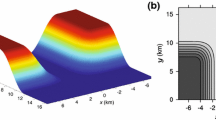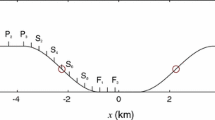Abstract
The boundary layer of the Elqui valley in the arid north of Chile exhibits several interesting phenomena, such as a very shallow convective boundary layer (CBL) during the day. In the morning, warming is observed in and above the CBL, while the humidity decreases in the CBL. At midday, in and above the CBL of the valley, the temperature stagnates. In the afternoon in the CBL the temperature decreases and humidity increases, although the latent heat flux is very low. Because the characteristic features of the valley atmosphere are hard to interpret from observations alone, model simulations were applied. The simulations indicate that all components of the budget equations, i.e. the turbulent flux divergences, advection via the sea breeze, the upvalley and upslope wind systems, as well as subsidence, contribute to the evolution of the valley atmosphere.
Similar content being viewed by others
References
Adrian G, Fiedler F (1991) Simulation of unstationary wind- and temperature fields over complex terrain and comparison with observations. Contr Phys Atmos 64: 27–48
Barry RG (1992) Mountain weather and climate. Routledge, London, p 402 pp
Bischoff-Gauß I, Kalthoff N, Fiebig-Wittmaack M (2006) The influence of a storage lake in the arid Elqui valley in Chile on local climate. Theor Appl Climatol 85: 227–241
Businger JA, Wyngaard JC, Izumi Y, Bradley EF (1971) Flux profile relationships in the atmospheric boundary-layer. J Atmos Sci 28: 181–189
Deardorff JW (1972) Parameterization of the planetary boundary layer for use in general circulation models. Mon Wea Rev 100: 93–106
Deardorff JW (1974) Three-dimensional numerical study of the height and mean structure of a heated planetary boundary layer. Boundary-Layer Meteorol 7: 81–106
Deardorff JW (1978) Efficient prediction of ground surface temperature and moisture with inclusion of a layer of vegetation. J Geophys Res 83: 1889–1903
Degrazia GA (1988) Anwendung von Ähnlichkeitsverfahren auf die turbulente Diffusion in der konvektiven und stabilen Grenzschicht (Application of the similarity procedure to turbulent diffusion in the convective and stable boundary layer). PhD thesis, Universität Karlsruhe
de Wekker SFJ, Steyn DG, Nyeki S (2004) A comparison of aerosol-layer and convective boundary-layer structure over a mountain range during STAAARTE ’97. Boundary-Layer Meteorol 113: 249–271
Fiedler F (1993) Development of meteorological computer models. Interdiscip Sci Rev 18: 192–198
Fiedler F, Bischoff-Gauß I, Kalthoff N, Adrian G (1999) Modeling of the transport and diffusion of a tracer in the Freiburg-Schauinsland area. J Geophys Res 105(D1): 1599–1610
Freytag C (1985) MERKUR results: aspects of the temperature field and the energy budget in a large alpine valley during mountain and valley wind. Contr Atmos Phys 58: 458–476
Gamo M (1996) Thickness of the dry convection and large-scale subsidence above deserts. Boundary-Layer Meteorol 79: 265–278
Garratt JR (1994) The atmospheric boundary layer. Cambridge University Press, Cambridge, p 316 pp
Hennemuth B (1985) Temperature field and energy budget of a small alpine valley. Contr Atmos Phys 58: 545–559
Hennemuth B, Neureither I (1986) Das Feuchtefeld in einem alpinen Endtal. Meteorol Rdsch 39: 233–239
Kalthoff N, Horlacher V, Corsmeier U, Volz-Thomas A, Kolahgar B, Geiß H, Möllmann-Coers M, Knaps A (2000) Influence of valley winds on transport and dispersion of airborne pollutants in the Freiburg-Schauinsland area. J Geophys Res 105: 1585–1597
Kalthoff N, Bischoff-Gauß I, Fiebig-Wittmaack M, Fiedler F, Thürauf J, Novoa E, Pizarro C, Castillo R, Gallardo L, Rondanelli R, Kohler M (2002) Mesoscale wind regimes in Chile at 30°S. J Appl Meteorol 41: 953–970
Kalthoff N, Fiebig-Wittmaack M, Meißner C, Kohler M, Uriarte M, Bischoff-Gauß I (2006) The energy balance, evapo-transpiration and nocturnal dew deposition of an arid valley in the Andes. J Arid Environ 65: 420–443
Khodayar S, Kalthoff N, Fiebig-Wittmaack M, Kohler M (2008) Evolution of the atmospheric boundary layer structure of an arid Andes valley. Meteorol Atmos Phys 99: 181–198
Klemp JB, Durran DR (1983) An upper boundary condition permitting internal gravity wave radiation in numerical mesoscale models. Mon Wea Rev 111: 430–444
Kossmann M, Corsmeier U, de Wekker SFJ, Fiedler F, Kalthoff N, Güsten H, (1999) Observation of handover processes between the atmospheric boundary layer and the free troposphere over mountainous terrain. Contrib Atmos Phys 72: 329–350
Kossmann M, Sturman AP, Zawar-Reza P, McGowan HA, Oliphant AJ, Owens IF, Spronken-Smith RA (2002) Analysis of the wind field and heat budget in an alpine lake basin during summertime fair weather conditions. Meteorol Atmos Phys 81: 27–52
Kuwagata T, Kimura F (1997) Daytime boundary layer evolution in a deep valley. Part II: Numerical simulation of the cross-valley circulation. J Appl Meteorol 36: 883–895
Kuwagata T, Kondo J, Sumioka M (1994) Thermal effect of the sea breeze on the structure of the boundary layer and the heat budget over land. Boundary-Layer Meteorol 67: 119–144
McGowan HA, Sturman AP (2005) Atmospheric boundary layer development over a narrow coastal plain during onshore flow. Meteorol Z 14: 3–14
Miller A (1976) The climate of Chile. In: Schwerdtfeger W(eds) World survey of climatology. Climates of Central and South America, Vol 12. Elsevier, Amsterdam, pp 113–145
Neininger B (1982) Mesoklimatische Messungen im Oberwallis. Ann Meteorol N F 19: 105–107
Noppel H, Fiedler F (2002) Mesoscale heat transport over complex terrain by slope winds—a conceptual model and numerical simulations. Boundary-Layer Meteorol 104: 73–97
Olivares S, Squeo F (1999) Patrones fenológicos en especies arbustivas del desierto costero del norte-centro de Chile. Revista Chilena de Historia Natural 72: 353–370
Orlanski I (1976) A simple boundary condition for unbounded hyperbolic flows. J Comput Phys 21: 151–269
Rutllant J, Ulriksen P (1979) Boundary-layer dynamics of the extremely arid northern part of Chile: the Antofagasta field experiment. Boundary-Layer Meteorol 17: 41–55
Schädler G, Kalthoff N, Fiedler F (1990) Validation of a model for heat, mass, and momentum exchange over vegetated surfaces using LOTREX-10E/HIBE88 data. Contr Phys Atmos 63: 85–100
Schemenauer RS, Cereceda P, Carvjal N (1987) Measurements of fog water deposition and their relationships to terrain features. J Clim Appl Meteorol 26: 1285–1291
Schemenauer RS, Fuenzalida PH, Cereda P (1988) A neglected water resource: the Camanchaca of South America. Bull Amer Meteor Soc 69: 138–147
Schwerdtfeger W (1976) Introduction. In: Schwerdtfeger W(eds) World survey of climatology. Climates of Central and South America, Vol 12. Elsevier, Amsterdam, pp 1–12
Squeo F, Osorio R, Arancio G (1994) Flora de Los Andes de Coquimbo: Cordillera de Doña Ana. Ediciones Universidad de La Serena, La Serena
Steinacker R (1994) Area-height distribution of a valley and its relation to the valley wind. Contr Atmos Phys 57: 64–71
Vergeiner I, Dreiseitl E (1987) Valley winds and slope winds—observations and elementary thoughts. Meteorol Atmos Phys 36: 264–286
Warner T (2004) Desert meteorology. Cambridge University Press, Cambridge, p 595 pp
Weigel AP, Rotach MW (2004) Flow structure and turbulent characteristics of the daytime atmosphere in a steep and narrow Alpine valley. Quart J Roy Meteorol Soc 130: 2605–2627
Weigel A, Chow F, Rotach M, Street RL, Xue M (2006) High-resolution large-eddy simulations of flow in a steep Alpine valley. Part II: flow structure and heat budgets. J Appl Meteorol 45: 87–107
Weischet W (1996) Regionale Klimatologie Teil 1, Die Neue Welt: Amerika, Neuseeland, Australien. Teubner, Stuttgart
Whiteman CD (1990) Observations of thermally developed wind systems in mountainous terrain. In Blumen (ed) Atmospheric processes over complex terrain. Meteorological monographs 23. American Meteorological Society, Boston
Whiteman CD (2000) Mountain meteorology. Oxford University Press, Oxford, p 355 pp
Whiteman CD, McKee TB, Doran JC (1996) Boundary layer evolution within a canyonland basin, Part I: mass, heat, and moisture budgets from observations. J Appl Meteorol 35: 2145–2161
Whiteman CD, Zhong S, Bian X, Fast JD, Doran JC (2000) Boundary layer evolution and regional-scale diurnal circulations over the Mexico Basin and Mexican plateau. J Geophys Res 105: 10081–10102
Zangvil A (1996) Six years of dew observations in the Negev Desert, Israel. J Arid Environ 32: 361–371
Author information
Authors and Affiliations
Corresponding author
Rights and permissions
About this article
Cite this article
Bischoff-Gauß, I., Kalthoff, N., Khodayar, S. et al. Model Simulations of the Boundary-Layer Evolution over an Arid Andes Valley. Boundary-Layer Meteorol 128, 357–379 (2008). https://doi.org/10.1007/s10546-008-9293-y
Received:
Accepted:
Published:
Issue Date:
DOI: https://doi.org/10.1007/s10546-008-9293-y




